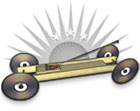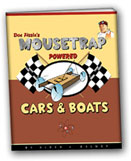Mousetrap Cars: Energy
Energy is the most important concept to understand before you build your own mousetrap racer. You cannot build a winning mousetrap racer until you know the basics.
Perhaps the single most important concept to understand in order to build a mousetrap powered car is the concept of energy. Energy is defined as having the ability to do work. Work is the displacement of an object that result in something being done. Without energy the universe would be motionless and without life. We usually observe energy only when it is happening or when it is being trans-formed from one form to another. Energy can be classified in a number of ways but most commonly energy is classified as potential and kinetic. The energy that is stored and/or held in readiness is called potential energy (PE). For example, a stretched or compressed spring has the potential to do work when released. When a bow is drawn energy is stored in the bow and when the bow is released the potential energy is used to launch the arrow. Kinetic energy (KE) is energy of motion or the energy a moving object has. From our example, the arrow now has kinetic energy because of it's motion just as a baseball thrown through the air also has kinetic energy because of it's motion.
potential energy: a loaded mouse trap has stored potential energy and that energy can be used to do work such as move a car.
Energy always follows one basic law called the Law of Conservation of Energy that states: Energy cannot be created or destroyed but it can be changed from one form to another but the total amount of energy in a system will remain constant. Loading the spring of a mouse trap stores potential energy and when that spring is released the potential energy is turns into kinetic energy or the energy of motion but the total amount of energy that the system starts with will always be the same as the energy the system ends with. In a perfect universe your mousetrap car would roll forever as the potential energy is changed into kinetic energy. But in our universe there is friction and in order to overcome friction your mousetrap car will have to do work. Friction converts the energy of a moving objects into heat and sound and this will eventually causes a moving object to come to a stop. Energy is not destroyed by this process but it is being converted into heat and sound. The total energy of a system at any moment in time is always the sum of the potential energy, the kinetic energy, and the total of the heat and sound energy.
bonus tip: Heat and sound are forms of energy caused by friction.
Power Output
Power output is the rate at which energy is being used. In a perfect universe where there was no friction this concept would not matter so much but in our real world environment friction makes a huge difference. In the real world heat and sound are forms of friction that will eventually absorbs all of the energy from a moving object and cause it to come to rest. Higher rates of energy output produce more heat and sound compared to smaller energy outputs. Slower moving objects with smaller power outputs will have less friction acting against their motion and will be more efficient.
bonus tip: slow moving mousetrap cars maximize the energy.
Building Your Mousetrap Car
Your goal when building a mousetrap car is to design a vehicle that limits the total loss of energy in the forms of heat and sound to the lowest possible rate; in other words, design an efficient vehicle that losses very little energy to friction as it moves. You can never eliminate friction but you can decrease the amount of friction acting against a vehicles motion in order to extend its travel distance and/or speed. Evaluate every moving component on your vehicle and try to decrease the total amount of friction at each point. As a general rule of thumb, the more moving components that a machine has, the greater the total force of friction.
Axle Points
The number one point of friction on any mousetrap car is where the axle system comes in contact with the frame of the vehicle. In most cases an axle will be in direct contact with the frame and there is a lot that can be done to decrease the friction at this contact point. Test spin your mousetrap racers wheels in order to see how friction-free they spin. If the wheels stop spinning fairly quickly then you will need to find ways to reduce the axle friction.
Friction at the axle points depends on:
- The diameter of the axle
- The pressure on the axle by the bearing
- The types of materials used for the axle and bearing
bearings: The number one point of friction on any mousetrap car is always at the bearings. Find ways to reduces the friction at the bearing points.
Air Resistance
Imagine you are in a pool of water, you will find that it is easy to walk around in the water but once you try moving fast or even try running in the water you immediately feel the resistance of the water pushing against your motion; this is the same experience a mousetrap vehicle will have as it tries to push it's way through the air. The faster a mousetrap vehicle moves the harder it will have to work to push more air out of the way and this take energy from the system. Design your mousetrap racer so that it can slice through the air with the least amount of resistance; design your vehicle to be aerodynamic. Try sanding and painting wood frames in order to cut down on the air resistance. If your mouse trap challenge is for maximum distance, then design you mousetrap car to be slow moving; this can be achieved by adjusting the vehicle's gearing.
Factors that effect the air resistance:
- the speed of the vehicle
- the shape of the vehicle
air resistance: design your mousetrap car to be slow moving and aerodynamic in order to decrease the force of friction and maximize the travel distance.
Mousetrap Cars and Power Output
With all speed-trap racers the objective is to get to this finish line as-fast-as possible. The perfect speed-trap racer will be geared to have a high energy output in order to get to top speed as soon as possible and then coast across the finish line. Speed-trap racers will not be as efficient and the forces of friction will be much higher compared to a long-distance mousetrap car but the objective of the contest is very different. Design your speed-trap racer to have a high energy output. Design your speed-trap racer to get to it's top speed as soon as possible. With all long-distance traveling mousetrap cars the objective is to maximize the starting energy over the longest distance and this means decreasing the energy lost to heat and sound to lowest possible rate. Slow moving long-distance mousetrap cars will experience less friction than faster moving racers. Design your long distance mousetrap car to move as slow as possible or have a low power output by extending the pulling force over the longest possible distance.
bonus tip: design your speed-trap racer to use all it's energy before the finish line.
bonus tip: slow moving mousetrap cars maximize the energy.
*Can't find what you're looking for? Ask Doc Fizzix »




